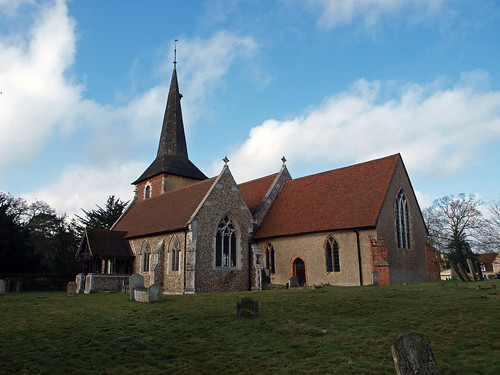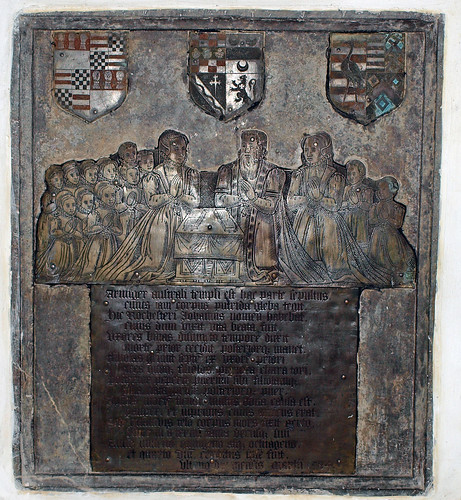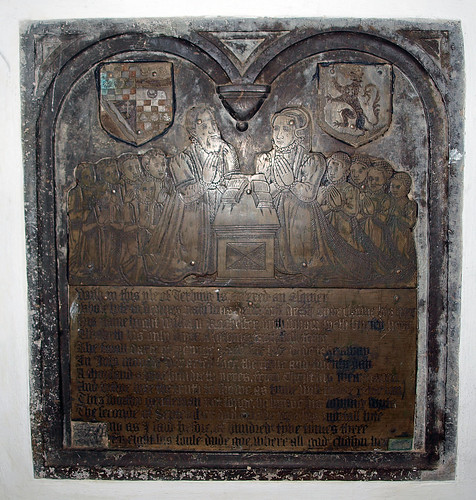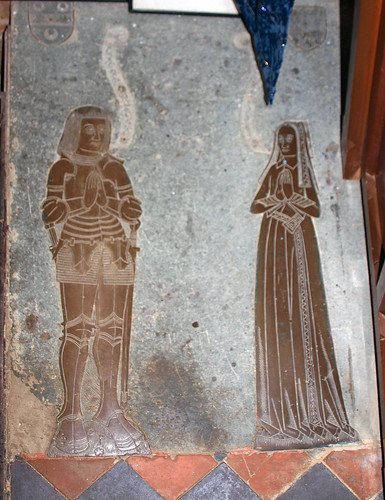It does, however, contain three really good brasses to the Rochesters - Sir John d.1514, William d. 1556 and John 1584. The chancel has a series of wall monuments to the Strutts ranging from 1919 to 2004 and a rather odd brick built mausoleum tacked on to the chancel takes them back to 1769.
ALL SAINTS. The best piece is the W tower of 1732 with arched doorway and arched windows, their surrounds consisting of rustication of alternating sizes. The rest not impressive from outside. C19 N aisle, completely renewed S aisle. The chancel seems to be of the C13. It has one small lancet window on the N side, and otherwise windows of c. 1300. Nice C15 timber porch. Inside, three-bay C15 N and S arcades with octagonal piers with concave sides and wave moulded arches. The low many moulded tower arch is proof of the existence of a previous C13 tower. - FONT. C13, octagonal, of Purbeck marble, with two shallow blank pointed arches on each side. - COMMUNION RAIL. Early C18, with slim twisted balusters. - BRASSES. Two groups of kneeling figures, of 1558 and 1584.
TERLING. The Terling countryside, through which the little River Ter flows at times under great forest trees, has a museum piece of its own in a smock mill with fine white sails 66 feet across, still working. It has one of the finest modern houses in Essex, home of the Rayleighs, standing in a magnificent park of 200 acres with the river flowing through it, and scattered about are farms and cottages that were here in our Tudor Age and must have been seen by Henry the Eighth, who had a palace here.
The village is rich in overhanging gabled roofs and Tudor chimneys. A grotesque little man crouches to bear a heavy beam at Eryat’s Farm, and the manor house, a dwelling-place of sheer delight, has 15th century foundations, windows of the two succeeding centuries, richly moulded timbering, and a view into the great park across its old-world garden. We do not wonder that here our great Tudor king lived in splendour, or that great folk lived here before him. The palace has vanished, but we know that here was a Norman chapel which was the scene of an act of ingratitude on the part of another King Henry that Bluebeard himself could hardly have surpassed for calculated cruelty. Here it was that Hubert de Burgh was forced from his sanctuary and carried off to the Tower by the young Henry the Third he had befriended.
The ruthless king had drawn his sword on Hubert, who was Justiciar of England, and had called him a traitor, and on Hubert seeking sanctuary in the chapel here had sent men down to fetter him and carry him off to the Tower. On the Bishop of London threatening to excommunicate all concerned, the king released the captive, but, in any case, before the bishop’s intervention the village smith, being ordered to fetter Hubert, had stubbornly refused. The king persisted in his persecution of the Justiciar, however, and though he dare not put him to death, finally sent him in chains to the Tower, from which Hubert escaped to Devizes and took sanctuary in the beautiful Norman church of St John, which would then be new. He was ultimately reconciled with his royal master. Far the better man of the two, Hubert is known in Shakespeare as the man who refused to put out Arthur’s eyes at the bidding of the ruffianly King John, and in history he is famous, it has been said, for being the first statesman "to convert the emotion of nationality into a principle of political action."
It is one of the few villages that have an ancient chapel. Across the green outside the churchyard stands the little Congregational building which has been here 250 years. It has a 17th century brass candelabra, by the light of which its people have sung their hymns since John Bunyan died; there are 12 branches, and a bird sits on the top. The church stands by the manor house, approached through a porch which has still its medieval timbers. The tower, crowned with a shingled spire with a dove for a weathervane, and carrying its bell outside, is of red brick and white stone, and is one of the 18th century towers, joining a 13th century wall. The church has brass portraits of William Rochester and his wife, who may have seen Henry the Eighth pass by, for they were laid here in the terrible reign of Mary Tudor. Their ten children kneel with them. On another brass 12 children kneel in groups with two mothers and their father, John Rochester, who died in the days of Queen Elizabeth.
In a quiet corner of the churchyard, joining the garden of Terling Place (which has a small gate into it), is a simple monument of red sandstone on which are the words, "For now we see in a glass darkly, but then face to face." It is the grave of one of the most learned men who ever lived in England, John William Strutt, third Lord Rayleigh. He was born at Maldon a few years after the Victorian Era began and lived till the end of the Great War.
He saw science revolutionised and played no small part in the revolution, and for nearly half a century he carried on his work at Terling. Learned as he was, he had the rare quality of making subtle things seem simple. In his collected works are 440 separate papers. They issued frequently and rapidly from his pen, whether he was quietly working at Terling or in the laboratory at Cambridge, whether he was thinking out deep problems or discovering the new gas argon with his friend Sir William Ramsay. He was one of the chief authorities on physical optics, and wrote 150 papers on this subject. We believe that it was he who first suggested that the blue of the sky is due to the shorter waves of light being scattered by the line particles of dust suspended in the air. He received the Nobel Prize, and was honoured by six of the highest distinctions England can bestow on any man: the Order of Merit, a Privy Councillorship, the Chancellorship of Cambridge University, the Presidency of the Royal Society and of the British Association, and a tribute on the walls of Westminster Abbey, which tells us with a modesty characteristic of himself that he was "an unerring leader in the advancement of natural knowledge."
Flickr.




No comments:
Post a Comment